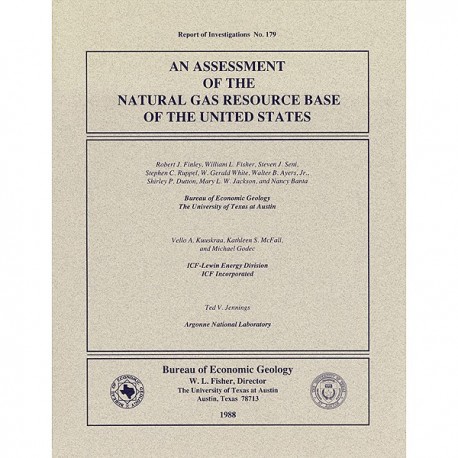Reports of Investigations
-
Books & Reports
- Reports of Investigations
- Guidebooks
- Udden Series
- Geological Circulars
- Down To Earth
- Atlases of Major Oil and Gas Reservoirs
- Texas Memorial Museum Publications
- Environmental Geologic Atlas of the Texas Coastal Zone
- Mineral Resource Circulars
- Other Reports
- Seminars and Workshops
- Handbooks
- Submerged Lands of Texas
- Symposia
- Annual Reports
- Open File Reports
-
Maps & Cross Sections
- Thematic Maps
- Miscellaneous Maps, Charts & Sections
- Geologic Atlas of Texas
- STATEMAP Project Maps
- Geologic Quadrangle Maps
- Cross Sections
- Highway Geology Map
- Energy and Mineral Resource Maps
- Shoreline Change and Other Posters
- Wilcox Group, East Texas, Geological / Hydrological Folios
- Bouguer Gravity Atlas of Texas
- River Basin Regional Studies
- Featured Maps
- Posters
- Teachers & the Public
-
Geological Society Publications
- Gulf Coast Association of Geological Societies
- Alabama Geological Society
- Austin Geological Society
- Corpus Christi Geological Society
- Houston Geological Society
- Lafayette Geological Society
- Mississippi Geological Society
- New Orleans Geological Society
- South Texas Geological Society
- GCS SEPM Publications
- Historic BEG & UT Series
An Assessment of the Natural Gas Resource Base of the United States
RI0179
For a downloadable, digital version: RI0179D.
RI0179. An Assessment of the Natural Gas Resource Base of the United States, by R. J. Finley, W. L. Fisher, S. J. Seni, S. C. Ruppel, W. G. White, W. B. Ayers, Jr., S. P. Dutton, M. L. W. Jackson, Nancy Banta, V. A. Kuuskraa, K. S. McFall, Michael Godec, and T. V. Jennings. 69 p., 34 figs., 27 tables, 5 appendices, 1988.
To purchase this publication as a downloadable PDF, please order RI0179D.
SUMMARY
Natural gas in the United States consists of proved reserves in known reservoirs, of inferred reserves and undeveloped resources within these reservoirs, and of undiscovered resources. Other than proved reserves, all volumes of future natural gas supply are estimates based on information derived from past and current experience in gas production and reservoir development. Even proved reserves are subject to periodic revision. This assessment was conducted starting with an understanding of major components of the natural gas supply based on existing resource estimates derived using established methodologies. In addition to historically defined elements of the resource base, a new component---reserve growth in heterogeneous reservoirs---is quantified in this study.
Resource assessments typically proceed from consideration of reasonably well known quantities (proved reserves) to consideration of increasingly less well known quantities (undiscovered resources). Natural gas reservoirs termed unconventional are usually reviewed separately, including gas in low-permeability reservoirs, gas in shale formations such as the Devonian of the Eastern United States, and coalbed methane resources. These approaches were followed in this assessment. Special note was made of Alaska gas reserves, which are significant and proven, but they were not included in total resource estimates because of the lack of transportation for North Slope gas to the lower 48 States.
A summary of the results of this assessment shows that a technically recoverable reserve and resource base of 1,059 trillion cubic feet (Tcf) of natural gas exists in the lower 48 States. This resource base is made up of proved reserves, inferred reserves, and resources. The latter requires discovery and development, in part based on improved understanding of reservoir frameworks that must be more fully developed and applied. Of this resource base, 800 Tcf exists or is estimated to exist in conventional reservoirs. More than half of the total resource evaluated in the lower 48 States, or 583 Tcf of gas, is judged economically recoverable (including finding costs) at <$3/Mcf (all prices are wellhead prices in 1987 dollars). An additional 174 Tcf of gas is judged economically recoverable at $3 to $5/Mcf. These judgments of economic recoverability were made by a national Review Panel of natural gas analysts who helped define the course of this study and made critical evaluations of assessment results. The Review Panel took a consistently conservative view of recoverability and of the total resource accessible at different price ranges. This was particularly true for unconventional resources, the resource base of which is much greater than the volumes of technically recoverable gas incorporated into this assessment.
The members of the Review Panel made individual estimates in each category of natural gas reserve or natural gas resource and then averaged them. The volume of gas judged economically recoverable in each category is the arithmetic mean of the individual estimates after elimination of the highest and the lowest estimate in each price category. The mean estimate and the range of the estimates (less the high and low values) reflect the range of judgment of the Review Panel.
Keywords: Alaska, lower 48 States, natural gas, reserves, reservoirs, resource assessment, resources, United States
Citation
Finley, R. J., Fisher, W. L., Seni, S. J., Ruppel, S. C., White, W. G., Ayers, W. B., Jr., Dutton, S. P., and others, 1988, An Assessment of the Natural Gas Resource Base of the United States: The University of Texas at Austin, Bureau of Economic Geology, Report of Investigations No. 179, 69 p.


